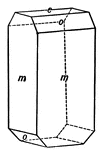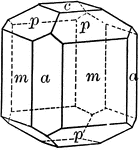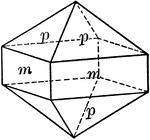This science ClipArt gallery offers 324 illustrations of crystals of numerous minerals. These crystalline minerals are created through natural processes, and so often times there are numerous crystal shapes for any given mineral (polycrystalline materials).
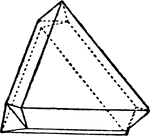
Two Octahedra
An illustration showing "two octahedra...united by contact along a surface parallel to an octahedron…
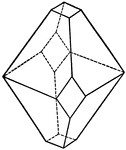
Union of a Pyramid and a Prism of Different Orders
This illustration shows the union of a pyramid and a prism of different orders.
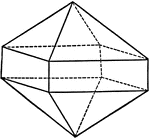
Union of a Pyramid and a Prism of the Same Order
This illustration shows the union of a pyramid and a prism of the same order.

Unsymmetrically Truncated Cube
This form is a cube with its edges unsymmetrically truncated by the faces of the pentagonal dodecahedron.

Vesuvianite
"Tetragonal. Prismatic in habit. Often vertically striated. Common forms are prisms of first and second…
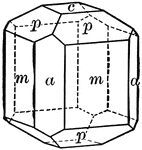
Vesuvianite
"Tetragonal. Prismatic in habit. Often vertically striated. Common forms are prisms of first and second…

Vesuvianite
This form shows a very complex combination of thirteen tetragonal forms occuring on the mineral Vesuvianite:…
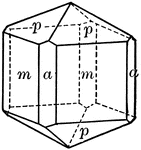
Wernerite
"Tetragonal; tripyramidal. Crystals usually prismatic. Prominent forms are prisms of the first and second…

Wernerite
"Tetragonal; tripyramidal. Crystals usually prismatic. Prominent forms are prisms of the first and second…
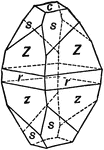
Yttrium Niobate
Also known as Fergusonite, this crystal shows the basal pinacoid, (c); the unit pyramid, (s); and the…
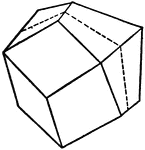
Zinc blende Contact Twin
This figure shows a contact twin of Zinc blende, one of the three simplest isometric holohedrons according…

Zincite
"A crystal of zincite with a prism terminated by a pyramid above a basal pinacoid below." — Ford,…

Zircon
"Tetragonal. Crystals usually show a simple combination of prism and pyramid of the first order. The…

Zircon
"Zircon, a mineral composed of of zirconium silicate, sometimes used as a gem-stone... THe mineral crystallizes…
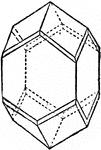
Zircon
"Zircon, a mineral composed of of zirconium silicate, sometimes used as a gem-stone... THe mineral crystallizes…

Zircon (Twinning)
In the tetragonal system, the unit pyramid of the second order is the most common twinning plane. This…
